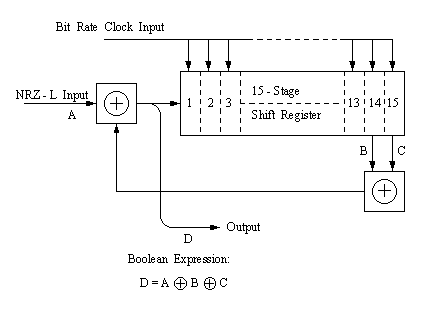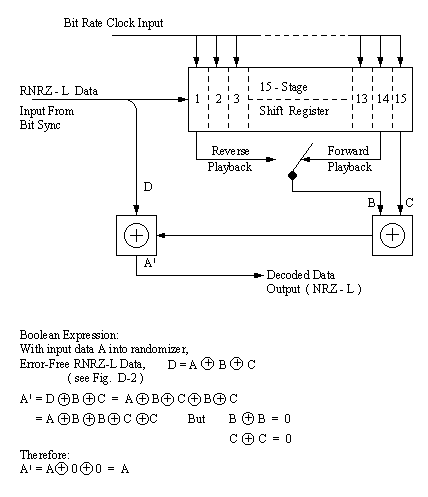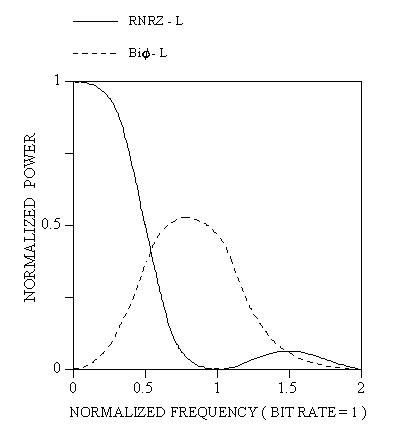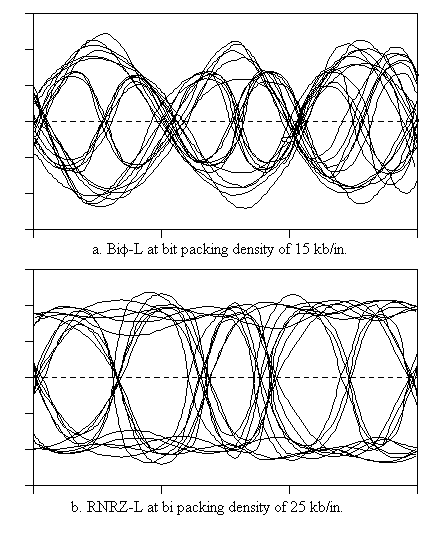|
MAGNETIC TAPE RECORDER AND REPRODUCER INFORMATION AND USE CRITERIA, Cont.... 1.0 Other Instrumentation Magnetic Tape Recorder Standards 2.0 Double-Density Longitudinal Recording 3.0 Serial HDDR 4.0 Head Parameters 5.0 Record Level 6.0 Tape Crossplay Considerations 7.0 Standard Tape Signature Procedures 8.0 Equipment Required for Swept-Frequency Procedures 9.0 Fixed-Frequency Plus White Noise Procedure 10.0 Signature Playback and Analysis 11.0 Recording and Playback Alignment Procedures 3.0 Serial HDDR The following subparagraphs give some background for selecting the bi-phase and RNRZ-L systems specified in subparagraph 6.11.3, chapter 6 of this document. 3.1 Serial HDDR is a method of recording digital data on a magnetic tape where the digital data is applied to one track of the recording system as a bi-level signal. The codes recommended for serial HDDR recording of telemetry data are Bi 3.2 In preparing paragraph 6.11 of chapter 6, the following codes were considered: Delay Modulation (Miller Code), Miller Squared, Enhanced NRZ, NRZ Level, NRZ Mark, and NRZ Space. These codes are not recommended for interchange applications at the bit rates given in paragraph 6.11. 3.3 The properties of the Bi 3.4 The Bi 3.5 Some characteristics of the Bi 3.5.1 Only a small proportion of the total signal energy occurs near dc. 3.5.2 The maximum time between transitions is a 1-bit period. 3.5.3 The symbols for one and zero are antipodal; that is, the symbols are exact opposites of each other. Therefore, the bit error probability versus SNR performance is optimum. 3.5.4 The Bi 3.5.5 The Bi 3.5.6 The Bi 3.6 The most unfavorable characteristic of the Bi 3.7 Characteristics of the RNRZ-L code which favor its use for serial HDDR are included in the following subparagraphs. 3.7.1 The RNRZ-L requires approximately one-half the bandwidth of Bi 3.7.2 The symbols for one and zero are antipodal; therefore, the bit error probability versus SNR performance is optimum. 3.7.3 The RNRZ-L decoder is self-synchronizing. 3.7.4 The RNRZ-L data can be bit synchronized and signal conditioned using existing bit synchronizers with the input code selector set to NRZ-L. 3.7.5 The RNRZ-L code is easily generated and decoded. 3.7.6 The RNRZ-L data can be easily decoded in the reverse mode of tape playback. 3.7.7 The RNRZ-L data are bit detected and decoded using a clock at the bit rate. Therefore, the phase margin is much larger than that of codes that require a clock at twice the bit rate for bit detection. 3.7.8 The RNRZ-L code does not require overhead bits. 3.8 Unfavorable characteristics of the RNRZ-L code for serial HDDR are described next. 3.8.1 Long runs of bits without a transition are possible although the probability of occurrence is low, and the maximum run length can be limited by providing transitions in each data word. 3.8.2 Each isolated bit error that occurs after the data has been randomized causes 3-bit errors in the derandomized output data. 3.8.3 The decoder requires 15 consecutive error-free bits to establish and reestablish error-free operation. 3.8.4 The RNRZ-L bit stream can have a large low frequency content. Consequently, reproducing data at tape speeds which produce PCM bit rates less than 200 kb/s is not recommended unless a bit synchronizer with specially designed dc and low frequency restoration circuitry is available. 3.9 Randomizer for RNRZ-L The randomizer is implemented with a network of shift registers and modulo-2 adders (exclusive-OR gates). The RNRZ-L bit stream is generated by adding (modulo-2) the reconstructed NRZ-L PCM data to the modulo-2 sum of the outputs of the 14th and 15th stages of a shift register. The output RNRZ-L stream is also the input to the shift register (see figure D-2).  3.9.1 The properties of an RNRZ-L bit stream are similar to the properties of a pseudo-random sequence. A 15-stage RNRZ-L encoder will generate a maximal length pseudo-random sequence of 215 -1 (32 767) bits if the input data consists only of zeros and there is at least a single one in the shift register. A maximal length pseudo-random sequence is also generated when the input data consists only of ones and the shift register contains at least a single zero. However, if the shift register contains all zeros at the moment that the input bit stream is all zeros, the RNRZ-L output bit stream will also be all zeros. The converse is also true: when the shift register is filled with ones and the input bit stream is all ones, the RNRZ-L output bit stream will contain only ones. In these two cases, the contents of the shift register does not change and the output data is not randomized. However, the randomizer is not permanently locked-up in this state because a change in the input data will again produce a randomized output. In general, if the input bit stream contains runs of X bits without a transition with a probability of occurrence of p(X), the output will contain runs having a length of up to (X+15) bits with a probability of (2-15 x p(X)). Therefore, the output can contain long runs of bits without a transition, but the probability of occurrence is low. 3.9.2 The RNRZ-L bit stream is decoded (derandomized) by adding (modulo-2) the reconstructed RNRZ-L bit stream to the modulo-2 sum of the outputs of the 14th and 15th stages of the shift register. The reconstructed RNRZ-L bit stream is the input to the shift register (see figure D-3). The RNRZ-L data which is reproduced using the reverse playback mode of operation is decoded by adding (modulo-2) the reconstructed RNRZ-L bit stream to the modulo-2 sum of the outputs of the 1st and 15th stages of the shift register (see figure D-3 ). The net effect is that the decoding shift register runs "backwards" with respect to the randomizing shift register.  3.9.3 Although the RNRZ-L decoder is self-synchronizing, 15 consecutive error-free bits must be loaded into the shift register before the output data will be valid. A bit slip will cause the decoder to lose synchronization, and 15 consecutive error-free data bits must again be loaded into the shift register before the output data is valid. The decoded output data, although correct, will contain the bit slip causing a shift in the data with respect to the frame synchronization pattern. Therefore, frame synchronization must be reacquired before the output provides meaningful data. 3.9.4 The RNRZ-L decoding system has an error multiplication factor of 3 for isolated bit errors (separated from adjacent bit errors by at least 15 bits). An isolated bit error introduced after randomization will produce 3 errors in the output data; the original bit in error, plus 2 additional errors 14 and 15 bits later. In addition, a burst of errors occurring after the data has been randomized will produce a burst of errors in the derandomized output. The number of errors in the output depends on the distribution of errors in the burst and can be greater than, equal to, or less than the number of errors in the input to the derandomizer. However, the derandomization process always increases the number of bits between the first and last error in the burst by 15. Errors introduced prior to randomization are not affected by either the randomizer or the derandomizer. The reverse decoder has the same bit error properties as the forward decoder. 3.9.5 Input data containing frequent long runs of bits without transitions creates potential dc and low frequency restoration problems in PCM bit synchronizers because of the low frequency cutoff of direct recorder and reproducer systems. The restoration problem can be minimized by reproducing the data at tape speeds that produce a bit rate for which the maximum time between transitions is less than 100 microseconds. Additional methods of minimizing these effects include selecting bit synchronizers containing special dc and low frequency restoration circuitry or recording data using Bi 3.9.6 The power spectra of the RNRZ-L and Bi  3.9.7 Alignment of the reproducer system is very important to reproducing high quality PCM data, that is, with the lowest possible bit error probability. A PCM signature using the standard 2047-bit pseudo-random pattern, recorded on the leader or the trailer tape, provides a good method for reproducer alignment. When a pseudo-random bit error detection system is not available or when a PCM signature signal is not recorded, the recommended procedure for reproducer alignment involves the use of the eye pattern technique. The eye pattern is the result of superpositioning the zeros and ones in the PCM bit stream. The eye pattern is displayed on an oscilloscope by inserting the raw reproduced bit stream into the vertical input and the reconstructed bit-rate clock into the external synchronization input of the oscilloscope. The reproducer head azimuth, amplitude equalizers, and phase equalizers are then adjusted to produce the eye pattern with the maximum height and width opening. 3.9.8 Sample eye patterns are shown in figure D-5. Figure D-5(a) shows a Bi  4.0 Head Parameters The following subparagraphs describe the head parameters. 4.1 Gap Scatter. Refer to the definitions in subparagraphs 6.2.30 and 6.2.31 in chapter 6. Gap scatter contains components of azimuth misalignment and deviations from the average line defining the azimuth. Since both components affect data simultaneity from record to reproduce, the measurement is the inclusive distance containing the combined errors. Because azimuth adjustment affects the output of wide band systems, a 5.08- 4.2 Head Polarity. The requirement that a positive pulse at a record amplifier input generate a south-north-north-south magnetic sequence and that a south-north-north-south magnetic sequence on tape produce a positive pulse at the reproduce amplifier output, still leaves two interdependent parameters unspecified. These parameters are (1) polarity inversion or noninversion in record and playback amplifiers and (2) record or playback head winding sense. For the purpose of head replacement, it is necessary that these parameters be determined by the user so that an unsuspected polarity inversion, on tape or off tape, will not occur after heads are replaced. 5.0 Record Level The standard record level is established as the input level of a sinusoidal signal set at the record level set frequency which, when recorded, produces a signal containing 1 percent third harmonic distortion at the output of a properly terminated reproduce amplifier (see subparagraph 4.1.3.3 of volume III, RCC document 118). A 1 percent harmonic distortion content is achieved when the level of the third harmonic component of the record level set frequency is 40 ±1 dB below the level of a sinusoidal signal of 0.3 UBE which is recorded at the standard record level. Standard test and operating practice is to record and reproduce sinusoidal signals at 0.1 and 0.3 UBE and adjust the equalizers as necessary to establish the reproduced output at 0.3 UBE to within ±1.0 dB of the output at 0.1 UBE. Then a 1 V rms signal at the record level set frequency is applied to the record amplifier input and the record and reproduce level controls are adjusted until the reproduced output contains 1 percent third harmonic distortion at a level of 1 V rms. The optimum level for recording data will seldom be equal to the standard record level. Signals having noise-like spectral distribution such as baseband multiplexes of FM subcarriers contain high crest factors so that it may be necessary (as determined in paragraph 1.1, Noise Power Ratio (NPR) Test, volume IV, RCC document 118, Test Methods for Data Multiplex Equipment ) to record at levels below the standard record level. On the other hand, for predetection and HDDR recording, signals may have to be recorded above the standard record level to give optimum performance in the data system. 6.0 Tape Crossplay Considerations Figure D-6 illustrates the typical departure from optimum frequency response that may result when crossplaying wide band tapes which were recorded with heads employing different record-head gap lengths. Line AA is the idealized output-versus-frequency plot of a machine with record bias and record level, set upper IRIG standards, using a 3.05- 6.1 The output curves have been normalized to 0 dB at the 0.1 UBE frequency for the purpose of clarity. The normalized curves may be expected to exhibit a ±2.0 dB variance in relative output over the passband. The tape recorded with the shortest head segment gap length will provide the greatest relative output at the UBE. 6.2 While the examples shown are from older equipment with record gap lengths outside the limits recommended in subparagraph 6.5.4, chapter 6, they illustrate the importance of the record gap length in tape interchange applications. |